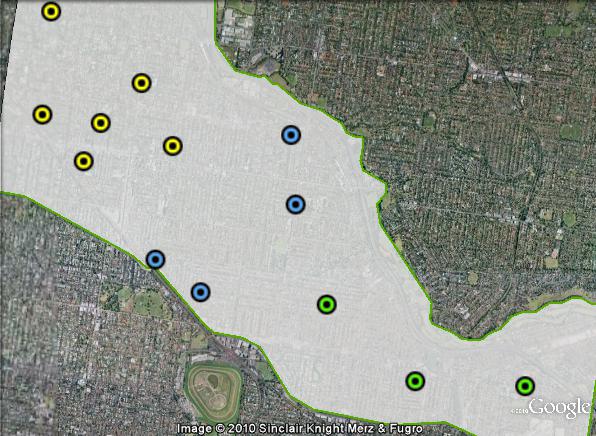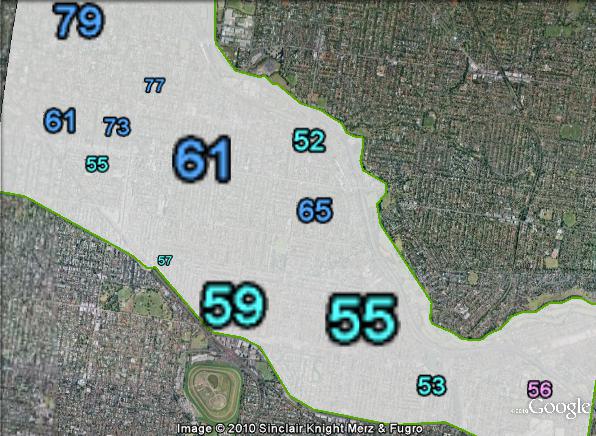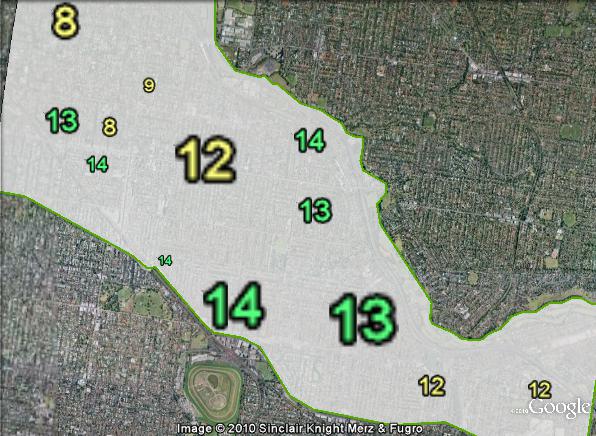LIB 11.3%
Incumbent MP
Michael O’Brien, since 2006.
Geography
Inner southeastern Melbourne. Malvern covers central and eastern parts of Stonnington local government area, specifically the suburbs of Armadale, Kooyong, Malvern and Malvern East and parts of the suburbs of Chadstone, Glen Iris and Toorak.
History
Malvern was first created for the 1933 election, and in that time it has always been won by the Liberal Party and its predecessor.
The seat was first won in 1945 by Trevor Oldham for the Liberal Party. Oldham had previously served as Member for Boroondara for the United Australia Party from a by-election in 1933 until the seat was abolished at the 1945 election. He served as Treasurer and Deputy Premier in a number of Liberal Party state governments, and was elected Liberal leader after the 1952 election. He died shortly after in an air crash on his way to the coronation of Queen Elizabeth II.
The seat was won at the 1953 by-election by John Bloomfield. He served as a minister in the Bolte Liberal government from 1955 to 1967, and retired at the 1970 election.
The seat was won in 1970 by Lindsay Thompson, who had served as a Member of the Legislative Council since 1955, first for Higinbotham province, and then Monash province. He had served as a minister in the Liberal government since 1958. Thompson became Premier of Victoria in June 1981, and served until his defeat at the March 1982 election.
Thompson resigned from Parliament following his election defeat, and the 1982 by-election was won by Geoff Leigh. He moved to the new seat of Mordialloc in 1992, and held it until his defeat in 2002.
Leigh had lost preselection for Malvern in 1992 to Robert Doyle. He served as a Parliamentary Secretary in the second term of the Kennett government and was promoted to the frontbench after Kennett’s defeat in 1999. In October 2002 he was elected Liberal leader, but lost badly at the state election the following month. He was replaced as Liberal leader in 2006 and retired from the seat of Malvern at the 2006 election. He went on to win election as Lord Mayor of Melbourne in 2008.
Malvern was won in 2006 by Michael O’Brien, a former advisor to Peter Costello. He serves in a number of shadow ministerial roles in the Liberal-National Opposition.
Candidates
- Michael O’Brien (Liberal)
- Miranda de la Masse-Homsy (Family First)
- Nick Voulanas (Labor)
- Samuel Hibbins (Greens)
Political situation
Malvern is one of the safest Liberal seats in Melbourne. O’Brien should have no trouble winning re-election.
2006 result
| Candidate | Party | Votes | % | Swing |
| Michael O’Brien | LIB | 17,927 | 56.88 | +1.74 |
| Paul Vout | ALP | 8,555 | 27.15 | -2.68 |
| Tania Giles | GRN | 3,959 | 12.56 | -0.86 |
| Deborah Holmes | PP | 590 | 1.87 | +1.87 |
| Ann Grauer | FF | 484 | 1.54 | +1.54 |
2006 two-candidate-preferred result
| Candidate | Party | Votes | % | Swing |
| Michael O’Brien | LIB | 19,313 | 61.32 | +1.14 |
| Paul Vout | ALP | 12,180 | 38.68 | -1.14 |
Booth breakdown
Booths in Malvern have been divided into three areas: east, central and west. The Liberal Party polls most strongly in the western end of the seat around Armadale and Kooyong, with over two thirds of the vote. They poll 60.8% in the centre of the seat, but a smaller 51.7% majority in the eastern end of the seat.

| Voter group | GRN % | LIB 2CP % | Total votes | % of votes |
| West | 11.01 | 67.33 | 10,578 | 33.59 |
| Central | 13.58 | 60.79 | 6,945 | 22.05 |
| East | 12.59 | 51.72 | 6,775 | 21.51 |
| Other votes | 13.84 | 64.11 | 7,195 | 22.85 |




It is fascinating that in the far West of the electorate the Green only scored 8%. One would have thought it would have been higher. I wonder if this means that the so-called Doctor’s wive small l liberal vote is weeker in Malvern than in say Hawthorn or Kew
Candidates in ballot paper order are:
Michael O’Brien – Liberal
Miranda de la Masse-Homsy – Family First
Nick Voulanas – Labor
Samuel Hibbins – Greens
Toorak is in the north west of Malvern electorate. It is not surprising that the green vote was so low in Toorak. Toorak is Melbourne’s wealthiest suburb. It is home to many members of the Australian ruling-class, some of whom are mining magnates. The people who vote in Toorak are hardly likely to be attracted to a party that is advocating better industrial relations policies than the A.L.P. Many members of the ruling-class are antagonistic to the Green’s environmental policies, such as the carbon tax, and the phasing out of our reliance on brown coal. Malvern also has a low green vote, because it too is an affluent suburb. The majority of people in Malvern, Kew, and Hawthorn electorates are not small l liberals, that is a fallacy, they are hard core conservative voters. The liberal Party is not a small l liberal party (unlike the U.S Democrats), they are a right wing nationalist conservative party. In 1982 Hawthorn was a marginal Liberal electorate, now it is the strongest Liberal Party electorate in metropolitan Melbourne, because at each state election it has been swinging further and further to the right. Unlike the electorates of Brighton and Malvern it has no working-class areas within its boundaries to soften the rightward shift. The electorate of Brighton takes in Elwood (in the north west of the electorate) which has a much lower socio-economic status than Brighton and it is overwhelmingly Labor with a strong Greens vote. In the south east of the electorate is the Labor voting working-class suburb of Highett. The inclusion of these two suburbs prevents Brighton electorate from being the strongest Liberal electorate in Melbourne. Malvern electorate takes in the working-class part of Malvern East that used to be part of Chadstone up until the late 1980’s. This area is Labor voting and it prevents Malvern from being the strongest Liberal seat in Melbourne. Hawthorn electorate, on the other hand, has no Labor voting area, as not one suburb within its boundaries is working-class. The Southern part of the suburb of Hawthorn returned a Liberal primary vote of 70% with a Greens vote of only 8%, the reason being is that this is most affluent area in Hawthorn . Many of the residents in this area are upper middle-class hard core rightists who are in no way small l liberal. Even Kew electorate has a Labor voting area located in the centre of the electorate. The boundaries of Hawthorn electorate should be shifted westward. The arch conservative wowser suburbs of Canterbury and Camberwell should be turfed out of the electorate and the Labor/ Greens voting eastern part of Richmond should take their place. This was how the electorate looked in the 1970’s, as it took in eastern Richmond, Hawthorn, Hawthorn East, and north west Glen Iris, Camberwell, and Canterbury were not included. This redistribution could cause Baillieu to lose his seat, unfortunately it would never happen, as every year many people have been advocating for this redistribution to take place but the VEC does not want anything to do with it.